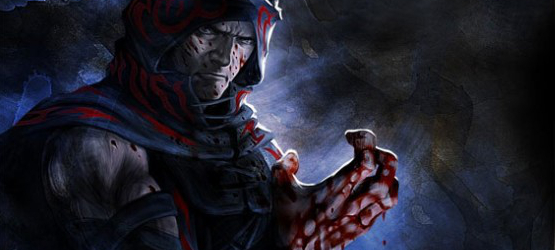Soul Sacrifice has earned a lot of comparisons to Monster Hunter, but most are unjustified and unfair to both games. Monster Hunter is about the thrill of the chase — hunting — for a giant monster by packing up appropriate supplies and traversing dangerous, often picturesque terrain and then fighting a huge beast. Soul Sacrifice, on the other hand, drops players right into battle, and finding the mark will take mere seconds. The focus in SS lies instead upon the combat itself, and once that is over, the dark story. The two might be placed within the same genre, but the functional similarities between the two are limited. Battlefield and BioShock might both be first-person games that involve shooting, but to call one a clone of the other would be inaccurate. In fact, one seeking a Monster Hunter clone with Soul Sacrifice might be surprised to find how dissimilar they are, with the latter having little to no emphasis on exploration, but instead much more on its combat, its story, and its spell management.
Unexpectedly, Soul Sacrifice‘s story is one of its best features — maybe one of the best on the Vita overall. In between missions, I found myself eager to learn more about the game’s world, its characters and history, and its inevitable future. Longtime fan of mission-based action RPGs have learned that their stories are often something of an afterthought, but Soul Sacrifice is a step up. Its tale is engaging and entertaining, thanks to its unique narration style, and interesting characters. I’m not even into Gothic settings and dark themes very often, but even I found myself enthralled by the world and tale of Soul Sacrifice.
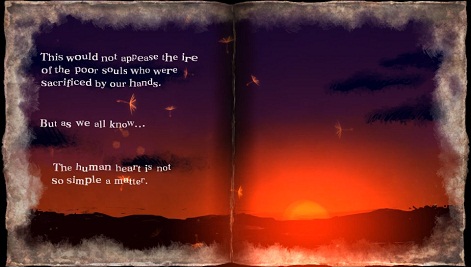
This tale changes with decisions the player makes in battle, namely the calls of whether to save or sacrifice the true/original forms the vicious monsters. Almost every enemy, including bosses, will writhe in pain and beg for its life once defeated. The player’s decisions on which ones to execute and which ones to rescue will impact their relevant story chapters and the growth of their sorcerer. Sacrificing monsters gives players increased magic power and a reload of spell casts, while saving them will boost one’s max health and defense, as well as restore a bit of health during battle. Each has its own separate level, but the two have a combined maximum of 100, so no one can simply decide to go into God Mode and max out both to have no weaknesses. It’s a game mechanic that properly reflects the theme of sacrifice, and it makes each decision feel important.
One will immediately notice Soul Sacrifice‘s dark, gloomy setting and environmental arrangement with its cages made of bones, platforms made of bones, pathways made of bones, and bones made of miscellaneous dark stuff. It’s gory and violent without being over the top — a game on which the word “mature” isn’t wasted as it is with so many others.
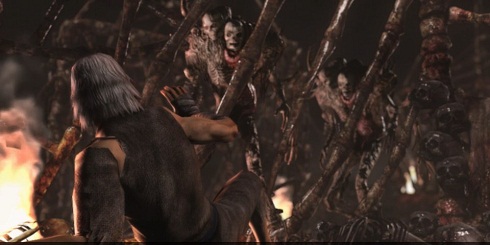
Progress is made by talking to the living book Librom, whose pages contain stories, quests, and access to character modifications. Reminiscent of Nier‘s Grimoire Weiss, he’s an occasionally sarcastic little guy whom a lot of players will love thanks to his entertaining dialogue. His genuine willingness to help the player make him a great supporting character, however. The strictest of bookworms might grow to dislike the way Librom undoes a portion of the story’s subtlety. Players will hear the tale and see the illustrations, only to have Librom soon tell them, in so many words, “Hey that was a plot twist and a real moral thinking point. Here’s what’s happening to the author, if you couldn’t tell. You should feel surprised and shocked right now.” It feels rather like a more specific “next episode” preview and “previously on _____” clip rolled into one. But whatever storytelling device he serves as, the book is an excellent addition to the game, and players will smile more than once during their interactions with Librom.
Librom’s stories aren’t just text on paper. Most pages are read aloud by the relevant characters, which serves to spice up the storytelling.
“Grinding” is a term inappropriately used with some games, to denote unwanted trips to the battlefield. But when the combat and other aspects are fun, is such a game really a “grind?” Of course not. The combat will draw comparisons to games like Phantasy Star Online, Monster Hunter, God Eater and Ragnarok Odyssey. Unlike those games, however, weapons, armor, and item inventory are of no concern in Soul Sacrifice, as everything is handled through magic spells. (Well, there are magic spells that cause weapons to burst forth from the character’s arm, but they’re not like pieces of equipment in the traditional sense.)
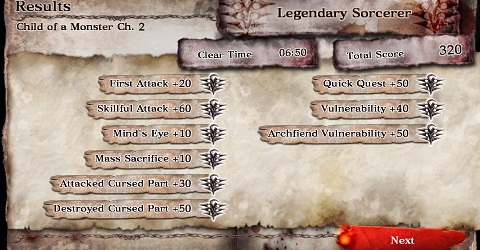
While the all-magic, action-RPG style combat is fun, the real addictive quality of Soul Sacrifice lies in its character building. I looked forward to the post-mission action much more than the battles in SS, because that’s where all of the spell fusion and right arm (the weapon of all sorcerers) customization is done. Equipping different collections of spells, developing new ones, and making older ones more powerful had me hardly wanting to put the Vita down. Playing old missions several times over in order to get multiple copies of their spoils became a regular occurrence.
“Well I’ll wrap up after I fuse a bunch of spells…. Since I did that, I might as well see how these things work…. Okay now I should take these in and whoop that next thing…. Whoa, I gotta see what happens next…. Oh hey I got more of the Jack-o-Lantern spell, I wonder if I can…why yes, yes I can….”
With how often diligent/addicted players will replay previous quests, it’s a small disappointment to see a lack of enemy variety in later ones. As the game goes on, new types of monsters do gradually appear, but one will very often find that the target is an old monster with more HP than it had last time.
Music is chillingly good. The haunting melodies of the menu screens and frantic tunes of combat stages add yet another welcome level of darkness to the adventure.
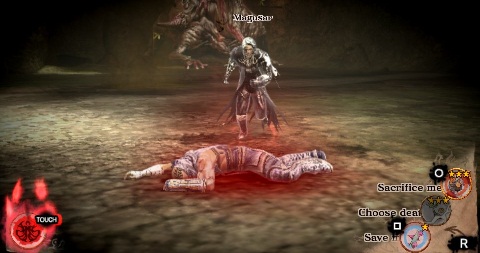
Multiplayer is available in ad-hoc and online modes, though the latter was not possible with the version provided. Players should also take note that the game requires an online pass. Time with the Japanese version, however, was very light on lag and ever a testament to the fact that other humans play much smarter than AI companions. At the time of this writing, I unfortunately can’t comment on the quality of online play outside of Japan, and Sony has not said whether or not various regions of players will be able to connect with each other in the multiplayer modes.
Soul Sacrifice offers a unique, engaging experience. Its quest structure makes it perfectly suited for a portable, yet its addictive nature will have a lot of players never wanting to put it down.
-
Atmosphere.
-
Story, and the telling thereof.
-
Mechanics that reflect the theme.
-
The music.
-
This is a unique game; don't put too much stock in the comparisons.
-
Addictive.
-
Enemy variety.
-
AI companions can make some frustratingly stupid decisions.
